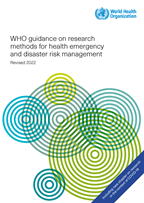- Home/
- Our Work/
- Health Emergencies/
- Research Methods/
- Sections and chapters/
- Section 4: Study design/
- Chapter 4.3 Cluster randomized trials
Section 4: Study design
Chapter 4.3 Cluster randomized trials

Research Methods for Health EDRM
Section navigation
- Section 4: Study design
- Chapter 4.3 Cluster randomized trials
- Chapter 4.1 Basic principles in designing studies to assess the effects of interventions
- Chapter 4.2 Measuring the problem: Basic statistics
- Chapter 4.4 Collection and management of good quality data
- Chapter 4.5 Advanced statistical techniques
- Chapter 4.6 Health-related risk modelling
- Chapter 4.7 Evaluating economic impacts in health emergency and disaster risk management
- Chapter 4.8 Geographic information systems
- Chapter 4.9 Real-time syndromic surveillance
- Chapter 4.10 Using logic models in research and evaluation of Health EDRM interventions
- Chapter 4.11 Researching communication and communicating research in Health EDRM
- Chapter 4.12 Qualitative research
- Chapter 4.13 Addressing complexity through mixed methods
- Chapter 4.14 Natural experiments in a hazard context
- Chapter 4.15 Monitoring and evaluation
Authors: Coldiron M, Grais RF.
Chapter 4.3 describes the role that cluster randomized trials can play in health emergency and disaster risk management (Health EDRM), including:
- The advantages and disadvantages of the cluster randomized trial methodology.
- Situations in which cluster randomized trials could be used.
- Potential difficulties in the implementation of cluster randomized trials and solutions for overcoming them.
What is this chapter about?
In some cases in Health EDRM, it might not be possible or appropriate to carry out an individual randomized trial to resolve uncertainties about the effects of interventions, actions and strategies because the interventions are delivered to groups of people. As an alternative, studies may be designed to randomize groups of participants as “clusters” in a cluster randomized trial.
This chapter describes how cluster randomized trials can be used to evaluate population-level interventions. It provides key information about the design, advantages, disadvantages and analysis considerations for cluster randomized trials. These include issues such as deciding whether a cluster trial is more appropriate than an individually randomised trial, the methods for obtaining informed consent from participants and the need to adjust the analyses to take account of clustering. The chapter contains case studies that describe a novel cluster randomized trial of vaccination against Ebola, and the use of a cluster randomized trial to test village-wide antibiotic prophylaxis for meningococcal meningitis and the informed consent process for this trial in Niger.
Case studies presented in the chapter:
- A novel cluster randomized design for evaluating Ebola vaccines.
- Testing a strategy of village-wide antibiotic prophylaxis during a meningococcal meningitis outbreak in the Madarounfa District of Niger.
- Obtaining permission to participate and the informed consent process in the cluster randomized trial of antibiotic prophylaxis in the Madarounfa District of Niger.
What are the key messages of this chapter?
- Cluster randomized trials are interventional studies well-adapted for many emergency situations and are ideal for evaluating population-level interventions.
- Compared to individually randomized trials, cluster randomized trials usually require larger numbers of participants and can be more complex to design and analyse.
- Cluster randomized trials can be parallel randomized or sequentially randomized, such as in a stepped-wedge design.
- The fundamental ethical principles are similar to those in individually randomized trials, but the Ottawa guidelines consider the particularities of cluster randomized trials.
- Design and analysis of cluster randomized trials requires careful reflection and the guidance of experienced researchers.
